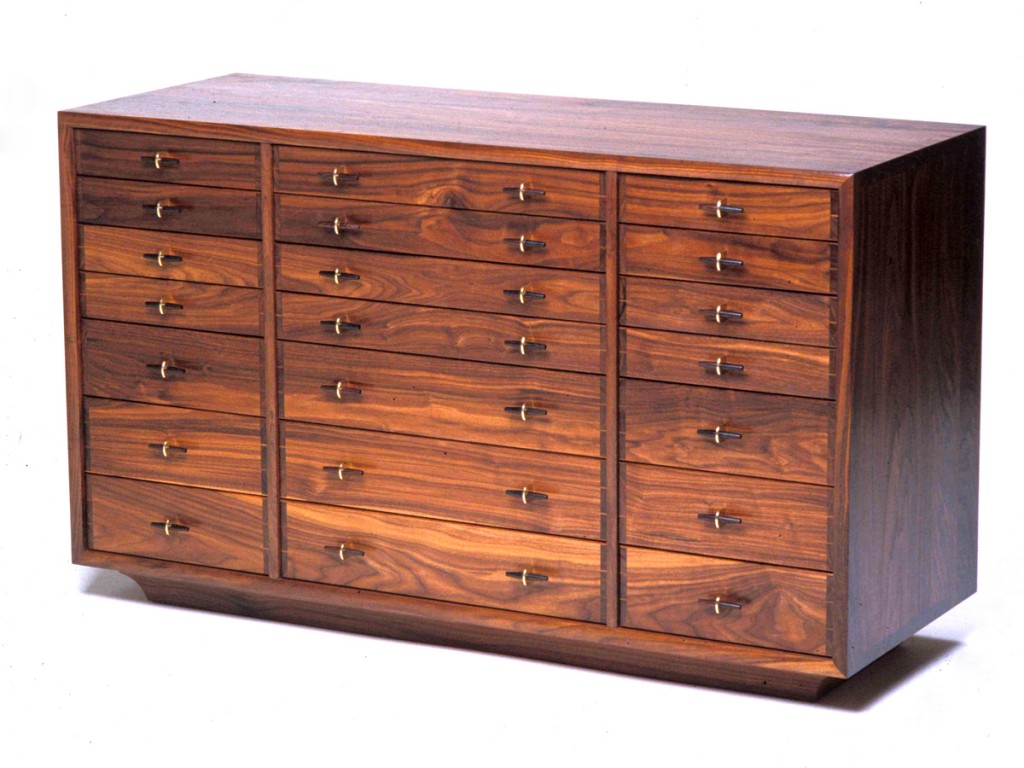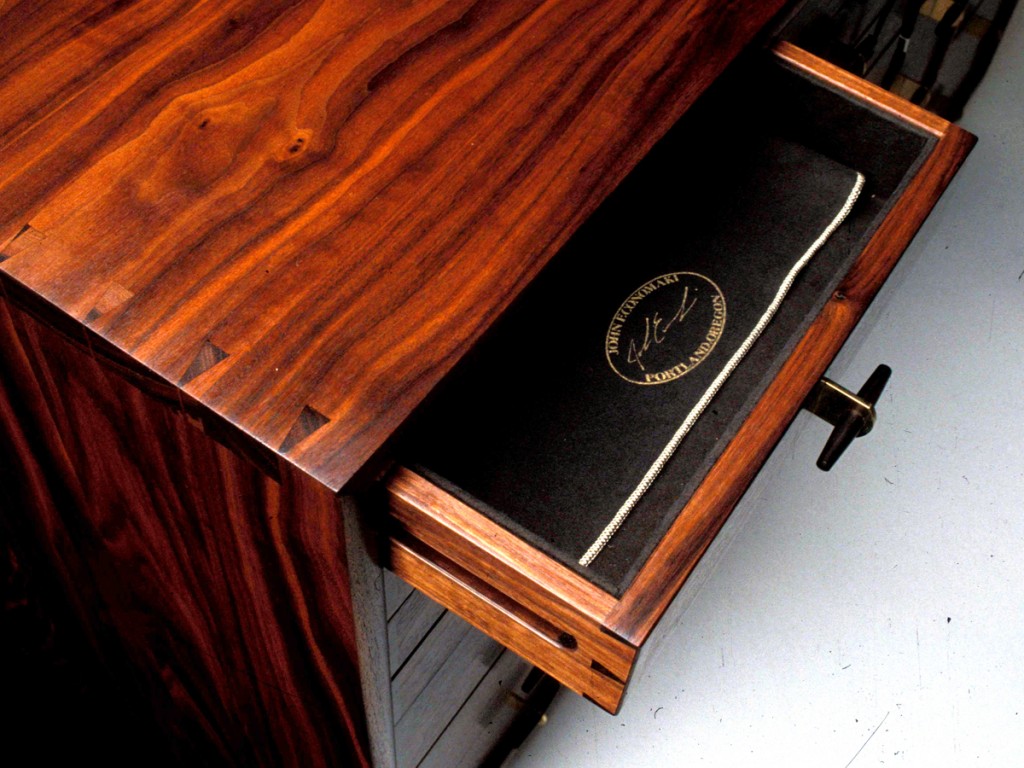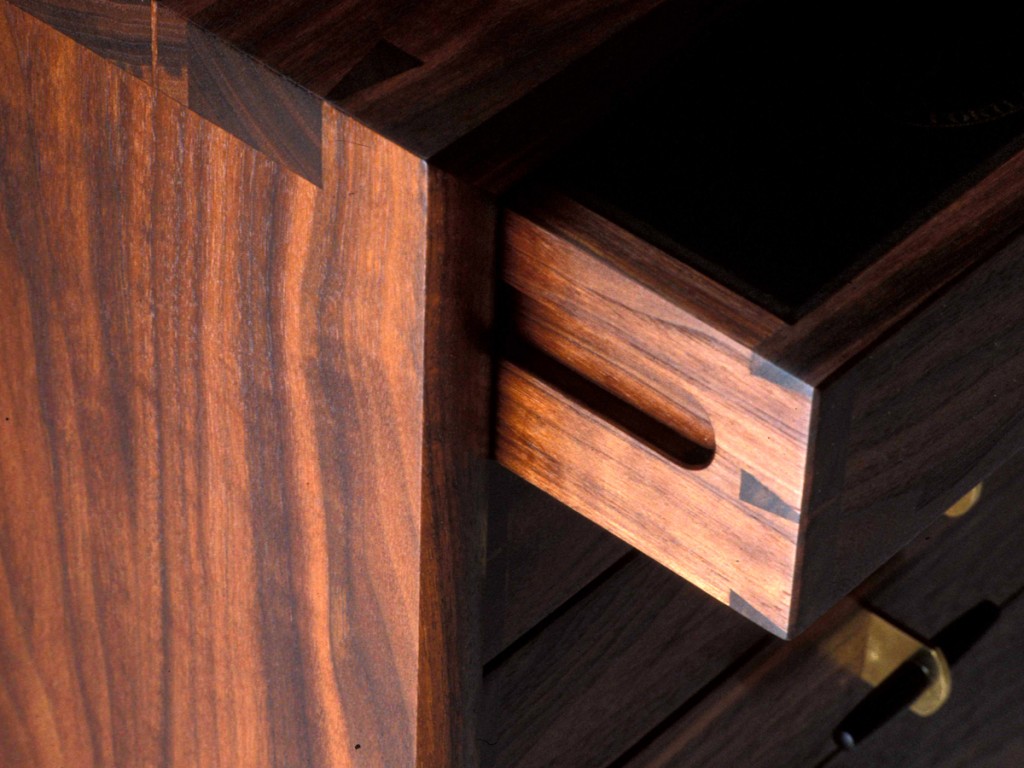Sometime in the late 1970’s I was commissioned by a San Diego couple to build a 21 drawer silver chest. They opted for hand dovetailed drawers. It was a cool commission because they traveled a lot and requested that the back of the chest look like the front of a cabinet.
Prior to one of their jaunts, they had some overripe teenagers turn the drawers to the wall. Presumably this would foil the “smash and grab” crooks that had them pegged as rich folks.
Because it is next to impossible to build one of anything profitably, I knew I was going to make two, one for them and one for the house–forget the fact that we did not own any silver silverware–had plenty of other less expensive stuff instead.
Combined, I had about 750 dovetails to cut. The parallelogram sled in the video below was my solution. As you will soon see, it was not difficult to knock out the pins in a day. Yes, I made the pins first, and then cut the sockets by hand. Pins/tails first–nobody cares–they just need to be spot on.
The sled in the video was made from stuff lying around our prototype shop. We had a couple of miter gage bars which was convenient, otherwise I would have purchased some 3/8″ x 3/4″ cold rolled steel bar. For the working surface we attached white plastic laminate to MDF with contact cement.
The four pivot studs (made from readily available 3/8″-16 threaded rod) are permanently attached (thread lock) to each end of the guide bars. The guide bars are attached to the top with 10-32 screws. Make the shank diameter of the 10-32 screws a bit over-sized and you will have no problem creating a smooth sliding table. You will need to know how to drill and tap.
The other two legs of the parallelogram are maple, with one hole and one slot. Once everything is assembled it is safe to cut the sled table in half.
The fences tilt about 30 degrees–any more and you risk the sled becoming unwieldy as the sled approaches the fulcrum point (the rear edge of your table saw top.)
The simple tenon jig attaches to the top via a “t” nut buried in the sled top. I was shocked how easy and fast this was to make using the KM-1 Kerfmaker.
This is a basic and really useful table saw accessory. You should see what you need to know to design your own version. There are plenty of opportunities to improve upon this basic design.
Drawbacks? You do lose a bit of cutting depth (thickness of the sliding table), and cross cutting width (you can remove the rear fence if need be) which negates this issue.
You will see this sled in future videos and the first coming up is the Tenonmaker!
If you have any questions, feel free to ask.
–John
This video is short but informative.
Here’s a front view of the chest. The pulls were made from steel bar, brass and rosewood.
This was from the ’70’s…the decade of exposed joinery. (I apologize for the quality of the images, all of my slides are being eaten by mold.)

The drawers were lined with Pacific Silver Cloth, a fabric embedded with silver particles that really helped the silver pieces stay nice and tarnish free. The October Company (also still in business after all these years) made the Pacific Silver Cloth drawer liners–they have a complete array of liners and holders for custom builders–they can also screen print your sig or logo as I had done.

The advantage of side hung drawers is twofold, you get more drawer space in a given vertical space and aligning the fronts is easily accomplished by adjusting the rails from the rear (prior to attaching the back). Even though these are side hung, they pass the “one finger test”–drawers close with one finger from any corner.


That’s a slick looking sled . What’s the feature plans for it . Is this something you’ll put into production or perhaps plans for it?
I wouldn’t peg that chest as being made in the 70s . It has a very timeless design to it. Beautiful wood and nicely crafted .
The sled is there to share. No plans for plans other than what you can see in this video–everybody has an idea or two to make it better. In other words, steal it.
Thanks for the compliments, not my intent at all.
–John
That sled is pretty slick.
I think designing something to last beyond the “period” you’re designing in is very difficult. You’re never quite sure if the ethos of the time will stand the test of time. But here you done good to quote Archie Bunker.
Never heard of Pacific Silver Cloth. Am Googling after this.
I like the pulls and I think side runners are the way to go. I detest the feel of drawers that run on metal and much prefer wood on wood. It’s the way it should be.
Nice jig, John. If only I had a table saw…
I love the chest – what’s it made of? Do you have any pictures of the back of it? Is its mate still in your house? Probably full of helicopter parts or something…
– Peter
Peter,
Thanks.
My children will be able to fight over the family silver chest…
Made from black walnut. I made the pulls from brass, steel, and rosewood. The back has three raised panels with 1/16″ maple banding inset into the flats of the raised panels (faux doors)-unfortunately I have a significant body of work from the 70’s and early 80’s and my photographic record is about 90% destroyed by mold-the pics of the back are ruined.
John
PS: I updated two links in the blog post regarding Pacific Silver Cloth and The October Company for anyone who is interested.
John,
What a great innovative idea! Now, have you given any thought to replacing the spinning saw blade with an upside down Japanese pull-saw blade?
Separate subject: Somewhere, some time ago, somebody told me that if you want to reduce wear on wooden drawer slides, you should use too different species of wood on the mating parts. i.e. Hard maple on oak, walnut etc. Have you ever heard of this?
Cheers,
Wayne
Wayne;
Like many things that eventually wear out, you strive for the least expensive part to wear, in this case the runners are way easier to make than repairing a drawer.
These drawers get opened maybe once or twice a year so in this case it is likely a non-issue. It is basically true with metals to prevent galling… FYI, the runners in the silver chest are teak for the natural oily state.
John
1000 dovetails. Wow. In rosewood no less. That is something I never want to have to do. You should post this over in the Original Designs forum.
I’m interested in the coved stand you made for the cabinet, John. I’m sure you went through a few iterations of how to support it. I think the pedestal looks wonderful with the weight of the cabinet above it, but I’m curious if you considered legs, or legs and stretchers?
– Peter
P.S. Awesome dovetails!
Peter,
I am a thematic designer and the design solutions distill through a really simple process.
I had constraints from the home, the drawer count and sizes, and, a glass art piece would sit on top. Without these, I would have opted for a progression in drawer sizes, and perhaps some other options as well. So…
I made the decision to keep it simple and crown the front edges. I just love this detail–it helps create shadows and shadows create depth. It then became a theme for the pulls and the toe-kick. The exposed joinery adds interest and is a subtle form of ornamentation to what is really a big box. The additions of subtle curves offsets the potential for rectilinear/planar monotony.
All that said, the piece has nice proportions and really that is what makes closer examination worthwhile.
I knew this thing was going to weigh a ton so I used a solid, mitered toe-kick. Which when under a weighty object creates a nice document hiding space…
At the end of the day, to my eye, the only logical solution that did not detract, and added to the whole, was what you see here. Surely it is not definitive, but I was incapable of accepting any of the other options I doodled out.
All of the elements, have to add–never be so strong or dis-associated that they detract.
Anyway that’s how I used to do it 30+ years ago in furniture…same rules apply to tool forms too.
Interestingly, back then I was a 20 something working my ass off. And really, nothing has changed–the same process I used on this chest applied to the the block plane that will be arriving on your doorstep real soon!
Best-
John
I can feel my cousins fearing for their inheritance every time they’ve seen me sit down on one of my aunt’s Nakashima chairs from the 70s….
“I can feel my cousins fearing for their inheritance every time they’ve seen me sit down on one of my aunt’s Nakashima chairs from the 70s…”
Lucky you!
-John
Actually, I don’t sit on them anymore–the chairs are substantially stronger than my cousins think, but no point proving it.
I did get lucky last fall–I took the train in from Harrisburg to get into the last day of the Nakashima exhibit at Moderne in Philly, and the place was closed during hours. I was getting ready to curse fate and growl at locals…and who pulls up but Mira Nakashima, who calls the owner on the phone and let me ask questions while she looked around with her son. I bought a wildly overpriced copy of her book from the gallery owner as thanks.
So, in re-reading your TWB post I see you said that the cabinet was a “27 drawer chest”. I’ve counted and counted, and I can still only see 21 drawers. Where are the other 6?!?
– Peter
Peter,
I would love to say I sold them six pair of boxer shorts–but can’t.
Fixed.
Thanks Professor.
Bummer. I was hoping that there were six secret drawers hidden somewhere (I actually looked…). I like your boxer-shorts solution better.
The other explanation could have been that they asked you for a 27 drawer chest, but you only made them a 21 drawer chest. Presumably to see how much they wanted the last 6 drawers, or something.
– Peter
I’m distressed to discover that this “San Diego couple” you made the chest for was not us. On the other hand, we didn’t live in San Diego in the ’70’s. Heck – I hadn’t even met Sharon then. Still – any chance we could arrange to go and visit your chest? Do they have any of your other pieces?
– Peter
P.S. Sorry for keeping this thread off topic. Though I’m not sure anyone in the DSN could tell…
After 30+ years I suspect these folks are no longer with us but I don’t know for sure–they would be in their 90’s.
-John
Hello John,
Your 21 drawer silver chest looks great, would you care to reveal your selected finish?
Mark
Simple and clever! Does the sled hold 90° To the blade or you need to adjust it every time? Thanks!
The sled holds 90 degrees as long as you don’t drop it.
John,
Thanks for the speedy reply! This is the most clever, elegant and versatile sled out there. Thank you for sharing!
Alex
You are welcome!